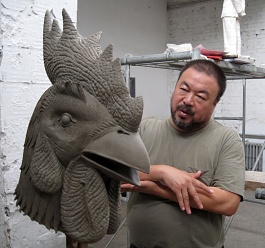
Before the Veletržní Palace stand the sculptures of the famous artist Ai Weiwei
Prague - In front of the Prague Trade Fair Palace, a sculpture by the world-renowned Chinese artist and critic of the local regime, Ai Weiwei, named Zodiac, has been installed since yesterday. The installation, which criticizes among other things the European military intervention in China in the 19th century as well as the contemporary art market, will be presented by the author at the end of next week in Prague. "For the first time, he will present it in person, as in previous cases he did not have a travel passport and could not attend the presentation of this collection," said Jiří Fajt, director of the NG, to ČTK.
He added that Zodiac is the first presentation of the work of this world-renowned artist in the Czech Republic. Next year, Ai Weiwei is expected to create a piece specifically for the National Gallery. The artist will be in Prague on February 5th and 6th, and apart from the exhibition opening, he will participate in two debates where the themes of human rights and migration will likely be discussed.
The more than one-meter tall bronze animal heads on tall stands will be in front of the Trade Fair Palace until the end of August. According to Fajt, the Czech Republic is one of the few places (alongside Denmark, Germany, Russia, and Spain) where the work has been or will be exhibited. The NG borrowed the example directly from the artist's collection. "We began negotiations for the presentation of Zodiac with Ai Weiwei last spring when we visited him in Beijing, then still as an unfree person who could not travel outside of China. In the summer, the situation changed, and further discussions continued in Berlin," said Fajt.
The sculptures were transported from Beijing by ship via Hamburg and were brought to Prague by cargo trucks. They were unloaded from enormous boxes today and erected and unpacked for several hours with the help of a crane to create a semicircle in front of the Trade Fair Palace.
Twelve Zodiac sculptures were created as copies of the statues designed by two European Jesuits for the court of Emperor Qianlong of the Qing dynasty in the 18th century. The originals formed a water clock at the fountain in the Old Summer Palace in Beijing; they were plundered by French and British soldiers during the Opium Wars in 1860. Their installation in public space is, according to Fajt, a reminder of the complex relationship between art, history, and politics and is closely related to the reflection on the mission and identity of exhibition institutions.
Zodiac was first exhibited in 2011 in New York's Central Park. It was a huge success, becoming one of the most famous works of contemporary Chinese art, and over the years, several copies have been made. A smaller version of the collection was sold at auction last year for a new authorship record of 4.3 million dollars (almost 104 million crowns).
Ai Weiwei has long criticized the Chinese regime. He is perhaps the most famous Chinese artist; even during his house arrest, his works appeared in prestigious galleries around the world, and he received international awards for his defense of human rights. Last year, Chinese authorities returned his passport. He immediately traveled to Berlin, where his family lives. In recent months, he has been critically expressing himself on the positions of some European countries on migrants. On the Greek island of Lesbos, he plans to erect a memorial to refugees heading to Europe. In the past week, in response to new asylum laws in Denmark, he decided to withdraw his works from museums and galleries there. Danish politicians have passed laws allowing the seizure of valuables from immigrants.











